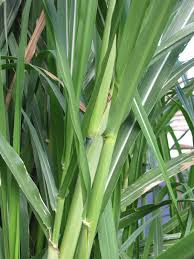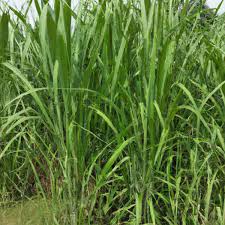Napier Grass, scientifically known as Pennisetum purpureum, is a type of tall grass that holds great significance in various parts of the world. This grass is renowned for its rapid growth, versatility, and numerous benefits, making it a favored choice for various purposes.
Napier Grass is commonly found in tropical and subtropical regions, where it thrives in warm and humid climates. Its ability to grow rapidly, sometimes reaching heights of up to 3 meters, has made it a popular choice for livestock feed. Farmers often cultivate Napier Grass as a reliable source of fodder for their animals, such as cattle, goats, and sheep. Its high growth rate ensures a consistent supply of feed, which is crucial for maintaining healthy and productive livestock.
Apart from its use as animal fodder, Napier Grass also plays a pivotal role in soil conservation. Its extensive root system helps prevent soil erosion, making it an excellent choice for areas prone to land degradation. The grass’s deep roots help bind the soil together, reducing the risk of topsoil being washed away by heavy rains or strong winds. This makes Napier Grass a valuable asset in sustainable agriculture practices and land management.
Furthermore, Napier Grass has gained recognition for its potential in bioenergy production. Its rapid growth and high biomass yield make it an attractive feedstock for producing biofuels, such as biogas and bioethanol. This renewable energy source has the potential to contribute to reducing the reliance on fossil fuels and mitigating greenhouse gas emissions.
In some regions, Napier Grass has been employed in phytoremediation efforts. This means that the grass is used to help clean up polluted or contaminated soils. The plants are capable of absorbing pollutants from the soil, thereby aiding in environmental cleanup and restoration.
It’s worth noting that while Napier Grass offers numerous benefits, its invasive nature can pose challenges in certain ecosystems. Its rapid growth and ability to outcompete native plant species can lead to ecological imbalances. As such, proper management and monitoring are crucial when introducing Napier Grass into new areas.
In addition, Napier Grass (Pennisetum purpureum) stands out as a versatile and valuable plant species with a wide range of applications. From providing livestock feed to soil conservation, bioenergy production, and phytoremediation, its contributions are diverse and impactful. However, it’s important to manage its growth carefully to ensure it doesn’t disrupt local ecosystems.
Read Also: How often you need to Change Water in your Fish Farm
Growing Napier Grass

Growing Napier Grass (Pennisetum purpureum) can be a rewarding endeavor, whether you’re a farmer looking for livestock feed or someone interested in its environmental benefits. Here’s a simple guide to help you successfully cultivate and manage Napier Grass:
1. Selection of Planting Site: Choose a sunny location with well-draining soil. Napier Grass prefers tropical or subtropical climates and grows best in areas with warm temperatures and ample sunlight.
2. Soil Preparation: Prepare the soil by tilling it to a depth of about 6-8 inches. Incorporate organic matter like compost to improve soil fertility and structure.
3. Planting: Napier Grass can be propagated through stem cuttings. Select healthy stems that are about 2-3 feet long and plant them in rows, leaving sufficient space between each cutting. Plant the stems about 2-3 feet apart within the rows.
4. Watering: Provide regular and consistent watering, especially during the initial stages of growth. Keep the soil evenly moist, but not waterlogged, to encourage healthy root development.
5. Fertilization: Apply a balanced fertilizer during the growing season to promote vigorous growth. Organic fertilizers or slow-release granules can be beneficial for providing a steady supply of nutrients.
6. Weed Control: Regularly weed the area around the Napier Grass to prevent competition for nutrients and sunlight. Mulching can also help suppress weed growth.
7. Pruning and Harvesting: Napier Grass can be harvested when it reaches a height of about 4-5 feet. Cut the stems just above the ground using sharp shears or a machete. Regular harvesting stimulates new growth and ensures a continuous supply of feed.
8. Pest and Disease Management:
Monitor the grass for signs of pests or diseases. Common pests include aphids and grasshoppers. Neem oil or insecticidal soap can be used to control pests. Practicing good sanitation and ensuring proper spacing can help prevent disease outbreaks.
9. Propagation: Napier Grass can be propagated by dividing mature clumps. Dig up the clump, separate the shoots, and replant them in well-prepared soil.
Remember that local climate and soil conditions may influence the specific growing practices needed. Consulting with local agricultural experts or extension services can provide you with tailored advice for successful Napier Grass cultivation in your area.
Caring for Napier Grass
Caring for Napier Grass (Pennisetum purpureum) involves several important steps to ensure its healthy growth and productivity. Here’s a care guide to help you maintain your Napier Grass effectively:
1. Soil and Site Selection: Choose a well-draining site that receives plenty of sunlight. Napier Grass thrives in fertile soil, so amend the soil with organic matter like compost before planting to improve its nutrient content.
2. Planting: Plant Napier Grass stem cuttings in rows with adequate spacing between plants. Planting them about 2-3 feet apart within rows will allow for proper growth and airflow.
3. Watering: During the establishment phase, provide regular watering to keep the soil consistently moist. Once the grass is established, you can reduce the frequency of watering, but ensure the plants receive enough moisture during dry periods.
4. Fertilization: Apply a balanced fertilizer with nitrogen,phosphorus, and potassium to promote healthy growth. Organic fertilizers or slow-release granules are good options. Follow the recommended application rates on the fertilizer packaging.
5. Mulching: Mulch around the base of Napier Grass plants to retain soil moisture, suppress weed growth, and improve soil structure. Use organic mulches like straw or wood chips.
6. Pruning and Harvesting: Regularly prune and harvest Napier Grass to encourage new growth and maintain a manageable height. Cut the stems just above the ground to stimulate fresh shoots. Harvest when the grass reaches around 4-5 feet in height.
7. Pest and Disease Management: Monitor the grass for signs of pests like aphids, grasshoppers, or diseases such as rust or fungal infections. Apply appropriate pesticides or treatments as needed, following the recommended instructions.
8. Preventing Invasiveness: Napier Grass can become invasive in certain environments. To prevent its spread, avoid planting it near natural habitats and manage its growth by regular pruning and monitoring.
9. Propagation and Maintenance: If you want to expand your Napier Grass planting, propagate through dividing mature clumps. Regular maintenance, including weeding and thinning, will ensure healthier growth and prevent competition for resources.
10. Sustainable Practices: Practice sustainable cultivation by avoiding over-fertilization, using natural pest control methods whenever possible, and considering the ecological impact of planting Napier Grass in your area.
11. Winter Care: In regions with colder winters, Napier Grass may die back in the cold season. Cut the grass back to a few inches above the ground before the first frost. It will regrow when warmer weather returns.
12. Monitoring and Adjustment: Regularly monitor the health and growth of your Napier Grass. Adjust your care routine based on its performance, local weather conditions, and any challenges you encounter.
Remember that local conditions may vary, so adapting your care routine to your specific climate and soil type will help ensure the best results. If you’re unsure about any aspect of caring for Napier Grass, consulting local agricultural experts or extension services can provide you with valuable guidance tailored to your region.
Read Also: Earthen Pond Management: Steps to take before putting the Fish in the Water
Benefits and Uses of Napier Grass

Napier Grass (Pennisetum purpureum) offers several powerful benefits and versatile uses that make it valuable in various contexts. Here are four of its most significant benefits and uses:
1. Livestock Feed: Napier Grass is a highly nutritious fodder that provides a substantial source of feed for livestock such as cattle, goats, and sheep. Its rapid growth and high biomass yield make it an excellent choice for farmers looking to sustain their animals throughout the year. This grass is rich in essential nutrients, including proteins and carbohydrates, which contribute to the overall health and productivity of livestock.
2. Soil Conservation and Erosion Control: With its extensive root system, Napier Grass plays a crucial role in soil conservation and erosion control. The deep roots help stabilize soil, preventing erosion caused by heavy rains and strong winds. By binding the soil particles together, Napier Grass minimizes the risk of topsoil being washed away, which helps maintain soil fertility and prevent land degradation.
3. Bioenergy Production: Napier Grass has gained recognition as a potential feedstock for bioenergy production. Due to its rapid growth and high biomass yield, it can be used to produce biofuels like biogas and bioethanol. These renewable energy sources offer an eco-friendly alternative to fossil fuels, contributing to sustainable energy production and reducing greenhouse gas emissions.
4. Phytoremediation and Pollution Control: Napier Grass exhibits phytoremediation properties, meaning it can help clean up polluted or contaminated soils. The grass absorbs pollutants from the soil, including heavy metals and organic compounds, thereby aiding in environmental cleanup and restoration efforts. Its ability to improve soil quality and reduce contamination makes it a valuable tool for mitigating the impacts of pollution.
In conclusion, Napier Grass offers powerful benefits and uses that span from providing vital livestock feed to contributing to soil conservation, renewable energy production, and environmental remediation. Its adaptability and rapid growth make it an asset in various agricultural, ecological, and sustainable development endeavors. However, it’s essential to manage its growth carefully to prevent potential invasiveness and ecological disruptions in certain regions.
Read Also: Types of Marketing Channels
